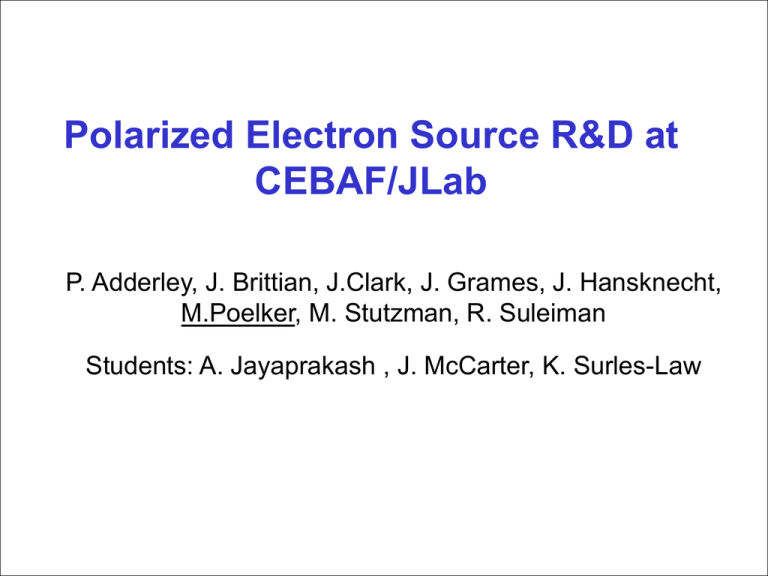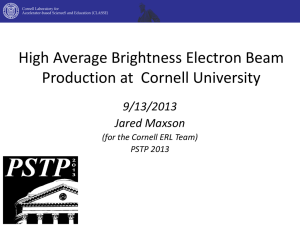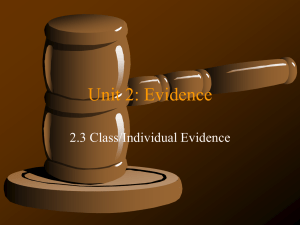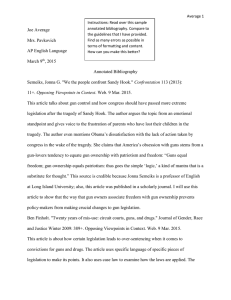Polarized Source
advertisement

Polarized Electron Source R&D at CEBAF/JLab P. Adderley, J. Brittian, J.Clark, J. Grames, J. Hansknecht, M.Poelker, M. Stutzman, R. Suleiman Students: A. Jayaprakash , J. McCarter, K. Surles-Law Recent Developments at CEBAF • CEBAF load-locked gun – Improved vacuum and accelerator-friendly ops • Commercial strained-superlattice photocathode – Consistent 85% polarization, ~ 1% QE – Demonstration of sustained 1mA operation • High Voltage R&D (just beginning: K. Surles-Law) – Reduce field emission – Push value of “routine” operation beyond 100kV – Reduce complexity and cost of HV insulator • Cathode/Anode Design (just beginning: A. Jayaprakash) – Optimize geometry to support loss-free beam delivery across entire photocathode surface CEBAF 100kV polarized electron source • Two-Gun Photoinjector - One gun providing beam, one “hot” spare • vent/bake guns – 4 days to replace photocathode (can’t run beam from one gun while other is baking) • Activate photocathode inside gun – no HV breakdown after 7 full activations (re-bake gun after 7th full activation) • 13 mm photocathode, but use only center portion, 5 mm dia. • Extract ~ 2000 Coulombs per year • Beam current ~ 100uA, laser 0.5mm dia., lifetime: ~ 100C, 1x105 C/cm2 Preparing for Demanding New Experiments Vent/Bake Guns: need improvement – Difficult to meet demands of approved high current/high polarization experiments like PRex (100uA) and Qweak (180uA and 1-year duration). – Our vent/bake guns can provide only ~ 1 week operation at 180uA – 12 hours to heat/reactivate, four days downtime to replace photocathode Design Goal for New Gun: One Month Uninterrupted Operation at 250uA, One Shift to Replace Photocathode New CEBAF load-locked gun Preparation/activation chamber Loading chamber HV chamber “suitcase” Vent/bake gun Key Features: • Smaller surface area • Electropolished and vacuum fired to limit outgassing • NEG-coated • Never vented • Multiple pucks (8 hours to heat/activate new sample) • Suitcase for installing new photocathodes (one day to replace all pucks) • Mask to limit active area, no more anodizing All new guns based on this basic design LL Gun and Test Beamline Y-scale: multiple variables QE scan 10 mA, 47C 7.5 mA, 54C Time (hours) 5 mA, 95C 1mA at High Polarization* Parameter Value Laser Rep Rate 499 MHz Laser Pulselength 30 ps Wavelength 780 nm Laser Spot Size 450 mm Current 1 mA Duration 8.25 hr Charge 30.3 C Lifetime 210 C Charge Lifetime 160 kC/cm2 * Note: did not actually measure polarization Note High Initial QE Vacuum signals Laser Power Beam Current “Lifetime Measurements of High Polarization Strained Superlattice Gallium Arsenide at Beam Current > 1 mA Using a New 100 kV Load Lock Photogun”, J. Grames et al., Particle Accelerator Conference, Albuquerque, NM, June 25-29, 2007 New LL Gun at CEBAF, Summer 2007 So far, lifetime no better than vent/bake gun. Why? Possible reasons for short lifetime • Need to “season” the gun • We have a leak (gun and/or beamline) • Beamline vacuum not as good at CEBAF (activate dif-pump NEGs and/or re-bake) • Field emission from cathode electrode (hi-pot gun to 125kV) • Gun ion pump exhibits field emission: need to hi-pot • Wrong magnet (solenoid) settings: beamloss at the bend chamber, Wien filter, etc • Activate the gun NEG pumps again…. Increase Gun Voltage: Why? Historically, Labs have had difficulty operating DC high voltage guns above field gradient ~ 5 MV/m and bias voltage ~ 100kV (at least polarized guns). That said, it would be beneficial to build an ILC gun with higher field gradient and bias voltage to... • Address current density limitation due to Child’s Law • Reduce space-charge-induced emittance growth, maintain smaller transverse beam profile and short bunchlength • Reduce problems associated with surface charge limit (i.e., QE reduction at high laser power) • Prolong Operating Lifetime? Space Charge Limit Peak current at ILC photocathode ~ 6 A Assume laser spot size 1cm Current density j = 7.6 A/cm2 Space Charge Limit (Child’s Law) j0 2.33 10 6 V03 2 d 2 V (kV) j0 (A/cm2) 140 14 200 23 350 53 At lower gun voltages, large laser spot is required. Must also consider charge limit at anode… for 3 cm cathode/anode gap Slide info courtesy Jym Clendenin, SLAC Surface Charge Limit QE reduction at high laser power Nagoya Peak to peak spacing 2.8ns, bunchwidth 0.7ns, Charge: 1nC/bunch Heavily doped surface: viable solution? 5.5 A/cm2 measured @ SLAC for 780 nm, 75 ns pulse 9.7 A/cm2 @ Nagoya for 780 nm, 30 ps ILC current density comparable to these values…something to worry about Slide info courtesy Takashi Maruyama, SLAC Improve Lifetime with Higher Bias Voltage? Ionization cross section for H2 Ion energy Most ions created at low energy, < 10kV 100kV 250kV Low energy ion column for 100kV gun Hypothesis: Double the gun voltage, halve the # of “bad” ions, improve lifetime by 2 Low energy ion column for 200kV gun Must Eliminate Field Emission Investigate the SRF-cavity technique “high pressure rinsing” Recent tests at JLab with shaped electrodes Work of M. Chetsova, K. Surles-Law FE from Handpolished 304 SS Cathode Electrode with ~6 mm gap FE Current (nA) 2500 2000 Hand Polished Hand Polished HPR 1500 Electropolished HPR 1000 CEBAF gun 500 0 0 5 10 15 20 25 -500 E-Field Gradient (MV/m) Ken preparing new electrodes, including single crystal Niobium… Cathode/Anode Design • We learned at CEBAF that it is extremely important to manage ALL of the extracted beam – Anodized edge: beam from outside 5 mm active area can hit beampipe walls, degrade vacuum, reduce operating lifetime • ILC requires large laser beam to reduce current density and overcome space and surface charge limit • Suggest detailed modeling of cathode/anode optic and first few meters of beamline – Perhaps using multivariate optimization? Goals of Cathode/Anode Design • Create cathode/anode optic with small aberration across large photocathode active area, with very little beam loss. What to optimize? – Size of cathode electrode diameter, size of photocathode active area – Size of laser beam: lowest possible current density but with adequate emittance – Cathode/anode shape for adequate focusing – Cathode voltage/gradient: higher voltage to reduce space charge and provide possibility of extracting higher peak current with more narrow laser pulsewidth, to reduce SHB requirements Inverted Gun Geometry e Present design •Medical x-ray technology •Ceramic not exposed to FE •Compact New design?





